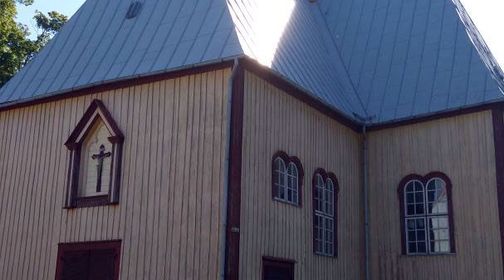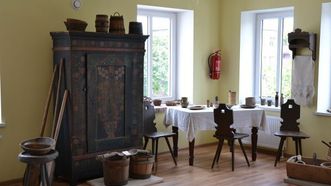
Žemaičių Naumiestis is an old town on the border of Samogitia, inhabited since the 14th century. The town gained special significance after the suppression of the Lithuanian press during the 1863-1864 uprising when it became an important point for distributing prohibited literature. It served as a crucial route for book smugglers. From 1910 to 1914, the Evangelical Lutheran priest Fridrikas Megnius published the newspaper "Svečias" in the Lithuanian language in Naumiestis, which was the only newspaper in Samogitia at that time. Over 100 years later, several copies of this newspaper were found while renovating the Evangelical Lutheran church rectory.
The cobblestone square of the old Naumiestis marketplace, relatively unchanged since the 19th century, reflects the multicultural life of this border town. The standing houses act as living exhibits, recalling the Jewish, Lithuanian, and Lithuanian-speaking shop fronts, stalls, and workshops. Naumiestis hosted two weekly markets, annual fairs, a customs office (on the border with Russia and Germany), about thirty shops and stalls, an electric power plant, a steam sawmill, a water mill, a knitting mill, a bakery, an elementary school, a gymnasium, a library, and more. The town was beautifully restored, well-planned, with paved sidewalks, a central square, and important streets.
During the establishment of Independent Lithuania, Naumiestis residents were active on various fronts. After the restoration of statehood in 1918, Naumiestis became the center of a district and was called Tauragė Naumiestis. In the 1940s, the town began to be called Žemaičių Naumiestis.
On the Vanagiai mound, also known as the Green Hill, proudly stands the Roman Catholic Church of St. Archangel Michael, built in 1782. It is a wooden church with elements of folk architecture and neo-Gothic features. The church houses artistically valuable religious paintings and sculptures. The current church building is cross-shaped with a small tower in the roof's cross. In 1842, a Lutheran church was built. Žemaičių Naumiestis was home to a vibrant Jewish community, evidenced by the large brick synagogue built in 1816 that still stands today. During the Soviet era, it housed a cultural center, and the now dilapidated building is no longer in use. In Žemaičių Naumiestis, everyone had their own place of worship.
The town's architecture has remained unchanged for many years, attracting filmmakers producing Lithuanian films. Every autumn, the picturesque Green Hill hosts the festival of harvesting the autumn crop – Dagotuvės. Naumiestis takes pride in the recent book "A Town by Lendra, Vanagis, and Šustis" by local author Albertas Juška.






